Phillips Petroleum Nu-Aviation Gasoline made aviation history in a deadly 1927 air race to Honolulu.
High-octane gas refined by Phillips Petroleum Company powered the “Woolaroc” monoplane to victory in a record-setting but deadly 1927 air race from California to Hawaii.
On a foggy summer morning in 1927, eight airplanes prepared for takeoff before a crowd of more than 50,000 at the Oakland Airport in California. Aviation history was about to be made over the Pacific Ocean with a 2,400-mile air race to Honolulu.
Aviation engine technologies had rapidly been advancing, thanks in part to Frank Phillips and Phillips Petroleum Company’s Nu-Aviation Gasoline, a powerful fuel developed by in Bartlesville, Oklahoma.
Deadly Dole Air Race
Four days after Charles Lindbergh’s famous transatlantic flight in May 1927, James Dole of the Dole Pineapple Company offered a $25,000 first prize for an air race of its own – across the Pacific from Oakland to Honolulu, Hawaii.

The 1927 air race’s Woolaroc plane was sponsored by Phillips Petroleum — today’s ConocoPhillips — a pioneer in early in aviation fuel research. Photo courtesy Phillips Petroleum Company.
Arthur Goebel Jr., a veteran barnstormer and Hollywood stunt pilot joined seven other aircraft in the race, which took place just three months after Lindbergh’s historic flight. The young pilot found a sponsor and friend in Frank Phillips, president of Phillips Petroleum Company, Bartlesville, Oklahoma.

The Woolaroc arrived safely in Hawaii after more than 27 hours in flight, winning the race. Others were not so lucky.
Phillips Petroleum — today’s ConocoPhillips — was involved early in aviation fuel research and had already provided high gravity gasoline for some of the first mail-carrying airplanes after World War I. But by 1927, aviation fuel technology was still in its infancy.
Phillips loaned Goebel $4,500 needed to take delivery of a Travel Air 5000 monoplane. Goebel promised to use a new aviation fuel developed by Phillips Petroleum for the planned flight over the Pacific. It was decided to name the airplane “Woolaroc,” the name of Frank Phillips’ ranch near Bartlesville.
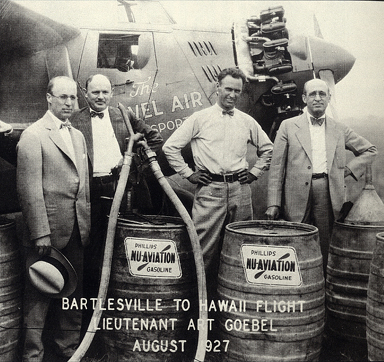
Phillips Petroleum vice presidents L.E. Phillips and Clyde Alexander, pilot Arthur Goebel Jr., and Frank Phillips stand with the 1927 racing airplane – Woolaroc. Photo courtesy Phillips Petroleum Company.
With an enthusiastic crowd of more than 50,000 cheering them on, the eight competing aircraft attempted to take off from the muddy Oakland Airport field at about noon on August 16, 1927.
Two of the fuel-heavy planes crashed on takeoff and others soon returned to the airport for repairs. Many aviators will perish on the way.
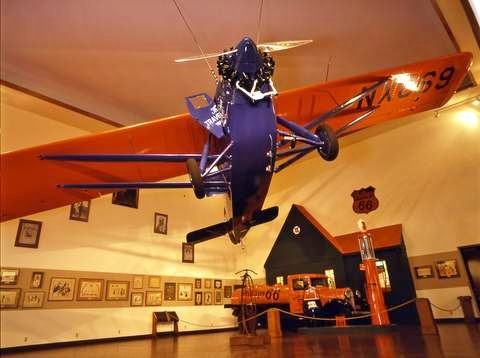
Frank Phillips’ Woolaroc ranch near Bartlesville, Oklahoma, added an Airplane Room to its museum in 1985 – a new home for the newly restored aircraft that won the 1927 race across the Pacific.
Early aviation was dangerous. Five aircraft eventually headed out over the Pacific. Only two would make it to Hawaii. Three aircraft and their crews disappeared forever over the ocean.
The Woolaroc arrived after 27 hours, 17 minutes and 33 seconds in flight, winning the race. The only other survivor, Aloha, a monoplane piloted by Martin Jensen, landed just over two hours later – with only four gallons of fuel remaining in its tanks.
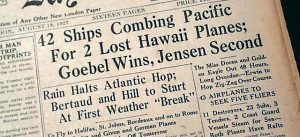
Only two of eight planes completed the 1927 Dole air race by landing in Hawaii.
Goebel won the $25,000 Dole prize, but six men and one aspiring “Aviatrix,” Mildred Doran, had died in the disastrous race. Sixty naval and merchant ships as well as navy and army aircraft searched for two weeks. No traces were ever found.
Despite the tragedy, Phillips Petroleum continued to pursue the aviation market. Today, the Phillips 66 Aviation name remains well known to pilots.
Quality Oil from Osage Fields
Phillips Petroleum Company produced aviation fuels before it produced automotive fuels.
The company’s gasoline came from the high-quality oil produced during the Osage County oil boom, which began in 1917. Jenk Jones Jr. notes the field’s special qualities in his Osage County History in March 2003.

100-octane aviation gasoline (avgas) was a vital fuel during World War II.
“The Osage fields were an oilman’s dream. The oil was a high grade, with a good conversion to gasoline ratio,” Jones explains. “It was easily refined, with a very high percentage of kerosene. It was free of sulfur and asphalt, and it came from several thick producing sands at relatively shallow depths,” the historian adds. “Phillips used it to produce the aviation gasoline that he proclaimed the best.”
Two years after the 1927 Dole Air Race, Frank Phillips brought his winning plane back to his Osage Hills ranch and built a hangar for it – the first building in what would become today’s Woolaroc Ranch and Wildlife Preserve.
The name Woolaroc combines three words – the woods, lakes and rocks that make up the beautiful Osage Hills of northeast Oklahoma where Woolaroc is located. The name, originally intended for the rustic lodge, soon became the name for the entire Frank Phillips ranch.
Will Rogers once said, “When you are visiting the beauty spots of this country, don’t overlook Frank Phillips’ ranch and game preserve in Bartlesville. It’s the most unique place in this country.”
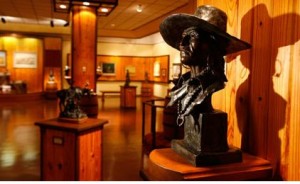
The Woolaroc’s art collection includes many masters of western art, including Frederic Remington, Charles M. Russell, William R. Leigh, Frank Tenney Johnson and Thomas Moran.
Phillips built a stone pavilion on the hill above the ranch’s lodge to house the plane. At first, the structure was just an open shelter with no door or windows. Glass display cases around the plane exhibited the oilman’s growing collection of guns, Indian relics, and other gifts not needed for decorating the lodge, which Phillips called his “airplane museum.”
Art acquisitions would later encroach on the space for the small aircraft. The museum expanded with additions in 1932 and 1939. The art collection also began to expand to achieve Phillips’ vision of “preserving the history of the West that he knew as a young man.”
With increased tourism in Oklahoma, people began asking to see Woolaroc. In 1938, a professional museum director began overseeing the preservation and presentation of the museum’s growing collection. Six years before his death in 1950, Phillips dedicated the Woolaroc Museum and Wildlife Preserve with these words:
“Those of us who have been more fortunate have a debt to society, which I believe can best be paid by training and educating the youth of the nation. I dedicate this museum to the boys and girls of today – the fathers and mothers of tomorrow. May they profit by a knowledge of man’s past and be enabled to plan and live a happier future.”
Woolaroc preserves the history of the Oklahoma oil and natural gas industry from the early teens through mid-century. The “Oil Patch” exhibit includes an authentic working powerhouse that uses rod lines to operate various working equipment on the lease.
Famed Aviator and Former Roughneck Wiley Post
Phillips Petroleum’s history with aviation fuel extends well beyond the Dole Air Race.
On July 22, 1933, before 50,000 cheering New York City onlookers, Wiley Post landed his Lockheed Vega “Winnie Mae” — becoming the first man to fly solo around the world.
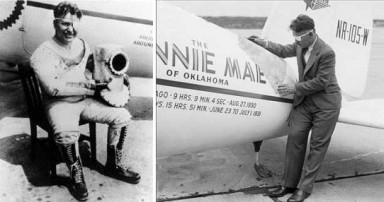
Thanks to Frank Phillips, Wiley Post will set altitude records — and be the first man to fly solo around the world.
Post developed a close relationship with Frank Phillips, who sponsored Post’s long-distance and high-altitude test flights.
Post’s trademark eye-patch resulted from his days working as an oilfield roustabout near Seminole. When a metal splinter damaged his eye in 1926, he used the $1,700 workman’s compensation check to buy his first airplane. His pressure suit and helmet are on display in the Phillips Petroleum Company Museum.
_______________________
Recommended Reading: Winners’ Viewpoints: The Great 1927 Trans-Pacific Dole Race (2009); Glory Gamblers
(1961); Oil Man: The Story of Frank Phillips and the Birth of Phillips Petroleum
(2016). Your Amazon purchase benefits the American Oil & Gas Historical Society. As an Amazon Associate, AOGHS earns a commission from qualifying purchases.
_______________________
The American Oil & Gas Historical Society (AOGHS) preserves U.S. petroleum history. Become an AOGHS annual supporting member and help maintain this energy education website and expand historical research. For more information, contact bawells@aoghs.org. © 2024 Bruce A. Wells.
Citation Information – Article Title: “Flight of the Woolaroc.” Authors: B.A. Wells and K.L. Wells. Website Name: American Oil & Gas Historical Society. URL: https://aoghs.org/transportation/flight-of-the-woolaroc-high-octane-aviation-fuel. Last Updated: January 25, 2024. Original Published Date: February 8, 2011.


